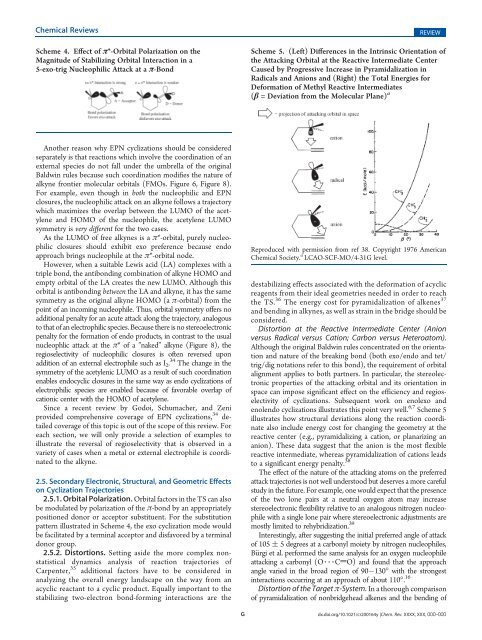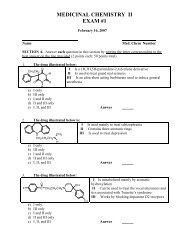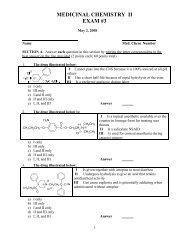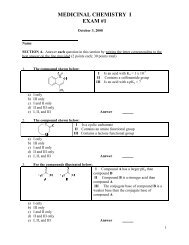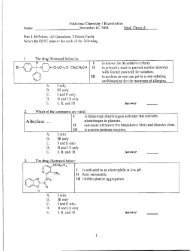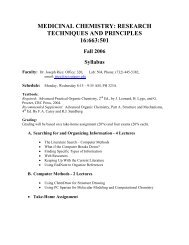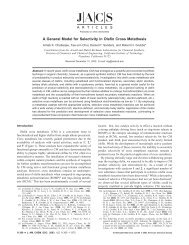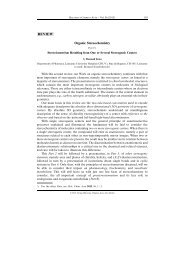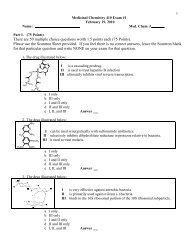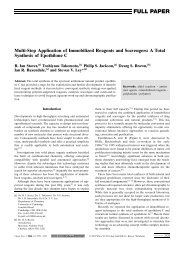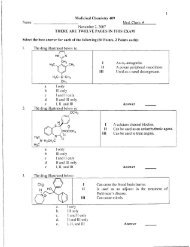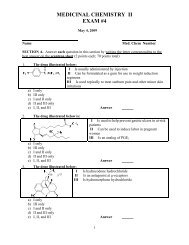Baldwin's Rules - Department of Medicinal Chemistry
Baldwin's Rules - Department of Medicinal Chemistry
Baldwin's Rules - Department of Medicinal Chemistry
Create successful ePaper yourself
Turn your PDF publications into a flip-book with our unique Google optimized e-Paper software.
Chemical Reviews REVIEW<br />
Scheme 4. Effect <strong>of</strong> π*-Orbital Polarization on the<br />
Magnitude <strong>of</strong> Stabilizing Orbital Interaction in a<br />
5-exo-trig Nucleophilic Attack at a π-Bond<br />
Another reason why EPN cyclizations should be considered<br />
separately is that reactions which involve the coordination <strong>of</strong> an<br />
external species do not fall under the umbrella <strong>of</strong> the original<br />
Baldwin rules because such coordination modifies the nature <strong>of</strong><br />
alkyne frontier molecular orbitals (FMOs. Figure 6, Figure 8).<br />
For example, even though in both the nucleophilic and EPN<br />
closures, the nucleophilic attack on an alkyne follows a trajectory<br />
which maximizes the overlap between the LUMO <strong>of</strong> the acetylene<br />
and HOMO <strong>of</strong> the nucleophile, the acetylene LUMO<br />
symmetry is very different for the two cases.<br />
As the LUMO <strong>of</strong> free alkynes is a π*-orbital, purely nucleophilic<br />
closures should exhibit exo preference because endo<br />
approach brings nucleophile at the π*-orbital node.<br />
However, when a suitable Lewis acid (LA) complexes with a<br />
triple bond, the antibonding combination <strong>of</strong> alkyne HOMO and<br />
empty orbital <strong>of</strong> the LA creates the new LUMO. Although this<br />
orbital is antibonding between the LA and alkyne, it has the same<br />
symmetry as the original alkyne HOMO (a π-orbital) from the<br />
point <strong>of</strong> an incoming nucleophile. Thus, orbital symmetry <strong>of</strong>fers no<br />
additional penalty for an acute attack along the trajectory, analogous<br />
to that <strong>of</strong> an electrophilic species. Because there is no stereoelectronic<br />
penalty for the formation <strong>of</strong> endo products, in contrast to the usual<br />
nucleophlic attack at the π* <strong>of</strong>a”naked” alkyne (Figure 8), the<br />
regioselectivity <strong>of</strong> nucleophilic closures is <strong>of</strong>ten reversed upon<br />
addition <strong>of</strong> an external electrophile such as I 2. 34 The change in the<br />
symmetry <strong>of</strong> the acetylenic LUMO as a result <strong>of</strong> such coordination<br />
enables endocyclic closures in the same way as endo cyclizations <strong>of</strong><br />
electrophilic species are enabled because <strong>of</strong> favorable overlap <strong>of</strong><br />
cationic center with the HOMO <strong>of</strong> acetylene.<br />
Since a recent review by Godoi, Schumacher, and Zeni<br />
provided comprehensive coverage <strong>of</strong> EPN cyclizations, 34 detailed<br />
coverage <strong>of</strong> this topic is out <strong>of</strong> the scope <strong>of</strong> this review. For<br />
each section, we will only provide a selection <strong>of</strong> examples to<br />
illustrate the reversal <strong>of</strong> regioselectivity that is observed in a<br />
variety <strong>of</strong> cases when a metal or external electrophile is coordinated<br />
to the alkyne.<br />
2.5. Secondary Electronic, Structural, and Geometric Effects<br />
on Cyclization Trajectories<br />
2.5.1. Orbital Polarization. Orbital factors in the TS can also<br />
be modulated by polarization <strong>of</strong> the π-bond by an appropriately<br />
positioned donor or acceptor substituent. For the substitution<br />
pattern illustrated in Scheme 4, the exo cyclization mode would<br />
be facilitated by a terminal acceptor and disfavored by a terminal<br />
donor group.<br />
2.5.2. Distortions. Setting aside the more complex nonstatistical<br />
dynamics analysis <strong>of</strong> reaction trajectories <strong>of</strong><br />
Carpenter, 35 additional factors have to be considered in<br />
analyzing the overall energy landscape on the way from an<br />
acyclic reactant to a cyclic product. Equally important to the<br />
stabilizing two-electron bond-forming interactions are the<br />
Scheme 5. (Left) Differences in the Intrinsic Orientation <strong>of</strong><br />
the Attacking Orbital at the Reactive Intermediate Center<br />
Caused by Progressive Increase in Pyramidalization in<br />
Radicals and Anions and (Right) the Total Energies for<br />
Deformation <strong>of</strong> Methyl Reactive Intermediates<br />
(β = Deviation from the Molecular Plane) a<br />
Reproduced with permission from ref 38. Copyright 1976 American<br />
Chemical Society. a LCAO-SCF-MO/4-31G level.<br />
destabilizing effects associated with the deformation <strong>of</strong> acyclic<br />
reagents from their ideal geometries needed in order to reach<br />
the TS. 36 The energy cost for pyramidalization <strong>of</strong> alkenes 37<br />
and bending in alkynes, as well as strain in the bridge should be<br />
considered.<br />
Distortion at the Reactive Intermediate Center (Anion<br />
versus Radical versus Cation; Carbon versus Heteroatom).<br />
Although the original Baldwin rules concentrated on the orientation<br />
and nature <strong>of</strong> the breaking bond (both exo/endo and tet/<br />
trig/dig notations refer to this bond), the requirement <strong>of</strong> orbital<br />
alignment applies to both partners. In particular, the stereolectronic<br />
properties <strong>of</strong> the attacking orbital and its orientation in<br />
space can impose significant effect on the efficiency and regioselectivity<br />
<strong>of</strong> cyclizations. Subsequent work on enolexo and<br />
enolendo cyclizations illustrates this point very well. 6,7 Scheme 5<br />
illustrates how structural deviations along the reaction coordinate<br />
also include energy cost for changing the geometry at the<br />
reactive center (e.g., pyramidalizing a cation, or planarizing an<br />
anion). These data suggest that the anion is the most flexible<br />
reactive intermediate, whereas pyramidalization <strong>of</strong> cations leads<br />
to a significant energy penalty. 38<br />
The effect <strong>of</strong> the nature <strong>of</strong> the attacking atoms on the preferred<br />
attack trajectories is not well understood but deserves a more careful<br />
study in the future. For example, one would expect that the presence<br />
<strong>of</strong> the two lone pairs at a neutral oxygen atom may increase<br />
stereoelectronic flexibility relative to an analogous nitrogen nucleophile<br />
with a single lone pair where stereoelectronic adjustments are<br />
mostly limited to rehybridization. 39<br />
Interestingly, after suggesting the initial preferred angle <strong>of</strong> attack<br />
<strong>of</strong> 105 ( 5 degrees at a carbonyl moiety by nitrogen nucleophiles,<br />
B€urgi et al. performed the same analysis for an oxygen nucleophile<br />
attacking a carbonyl (O 333 CdO) and found that the approach<br />
angle varied in the broad region <strong>of</strong> 90 130° with the strongest<br />
interactions occurring at an approach <strong>of</strong> about 110°. 16<br />
Distortion <strong>of</strong> the Target π-System. In a thorough comparison<br />
<strong>of</strong> pyramidalization <strong>of</strong> nonbridgehead alkenes and the bending <strong>of</strong><br />
G dx.doi.org/10.1021/cr200164y |Chem. Rev. XXXX, XXX, 000–000


